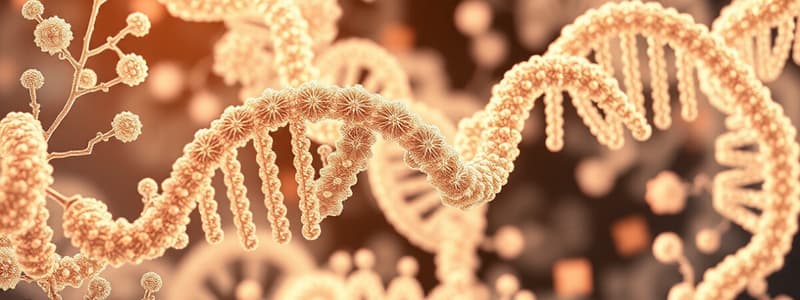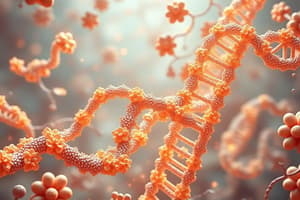Podcast
Questions and Answers
During translation, the language of nucleotides is translated into the language of:
During translation, the language of nucleotides is translated into the language of:
- Fatty acids
- Lipids
- Carbohydrates
- Amino acids (correct)
The anticodon is a sequence found on mRNA that binds to the tRNA.
The anticodon is a sequence found on mRNA that binds to the tRNA.
False (B)
What is the role of aminoacyl-tRNA synthetase in translation?
What is the role of aminoacyl-tRNA synthetase in translation?
Aminoacyl-tRNA synthetase attaches the correct amino acid to its corresponding tRNA molecule.
The phenomenon that allows one tRNA to recognize multiple codons is known as ______ pairing.
The phenomenon that allows one tRNA to recognize multiple codons is known as ______ pairing.
Match the ribosomal site with its function during translation:
Match the ribosomal site with its function during translation:
Which of the following is the correct order of events during translation elongation?
Which of the following is the correct order of events during translation elongation?
Translation continues until the ribosome encounters a codon that codes for an amino acid.
Translation continues until the ribosome encounters a codon that codes for an amino acid.
What is the function of release factors in translation termination?
What is the function of release factors in translation termination?
A ______ is an assemblage of mRNA, ribosomes, and their growing polypeptides, increasing the rate of protein synthesis.
A ______ is an assemblage of mRNA, ribosomes, and their growing polypeptides, increasing the rate of protein synthesis.
Match the post-translational modification with its description:
Match the post-translational modification with its description:
What is the primary role of signal sequences in proteins?
What is the primary role of signal sequences in proteins?
Removing a signal sequence from a protein will not affect its cellular destination.
Removing a signal sequence from a protein will not affect its cellular destination.
Which ribosomal RNA is responsible for peptide bond formation?
Which ribosomal RNA is responsible for peptide bond formation?
In prokaryotes, what sequence upstream of the start codon AUG is recognized by the 16S rRNA in the small subunit of the ribosome?
In prokaryotes, what sequence upstream of the start codon AUG is recognized by the 16S rRNA in the small subunit of the ribosome?
Initiation of translation in eukaryotes depends on the recognition of the Shine-Dalgarno sequence.
Initiation of translation in eukaryotes depends on the recognition of the Shine-Dalgarno sequence.
What structural feature of eukaryotic mRNA is recognized during translation initiation?
What structural feature of eukaryotic mRNA is recognized during translation initiation?
Which of the given processes is included in post-translational modifications?
Which of the given processes is included in post-translational modifications?
The signal sequence directs proteins to their final destination and is encoded in the protein's ______.
The signal sequence directs proteins to their final destination and is encoded in the protein's ______.
Signal sequences are only found on proteins destined for secretion.
Signal sequences are only found on proteins destined for secretion.
Which of the given steps explains how a protein is allowed to enter the endoplasmic reticulum?
Which of the given steps explains how a protein is allowed to enter the endoplasmic reticulum?
Match the terms with their descriptions.
Match the terms with their descriptions.
What binds release factor to allow hydrolysis between the polypeptide chain and tRNA?
What binds release factor to allow hydrolysis between the polypeptide chain and tRNA?
A single mRNA cannot be translated simultaneously by multiple ribosomes.
A single mRNA cannot be translated simultaneously by multiple ribosomes.
What are tRNAs?
What are tRNAs?
The triple in the tRNA that binds a codon in mRNA is called an ______.
The triple in the tRNA that binds a codon in mRNA is called an ______.
Which of the following statements explains better the ribosomes' function?
Which of the following statements explains better the ribosomes' function?
Once a protein is created, it always remains in the cytosol.
Once a protein is created, it always remains in the cytosol.
What step is needed after the translation of a new protein to be functional?
What step is needed after the translation of a new protein to be functional?
Adding or removing ______ sequences changes protein destination in the cell.
Adding or removing ______ sequences changes protein destination in the cell.
Match the translation site with its action.
Match the translation site with its action.
Flashcards
Translation
Translation
The process where the nucleotide sequence of mRNA is converted into the amino acid sequence of a protein.
Transfer RNA (tRNA)
Transfer RNA (tRNA)
Molecules that read the genetic code; they are about 80 nucleotides long and fold into a cloverleaf shape.
Anticodon
Anticodon
The triple of tRNA that binds a codon in mRNA.
Aminoacyl-tRNA synthetase
Aminoacyl-tRNA synthetase
Signup and view all the flashcards
Wobble base pairing
Wobble base pairing
Signup and view all the flashcards
Ribosome
Ribosome
Signup and view all the flashcards
A site (aminoacyl-tRNA)
A site (aminoacyl-tRNA)
Signup and view all the flashcards
P site (peptidyl-tRNA)
P site (peptidyl-tRNA)
Signup and view all the flashcards
E site (exit)
E site (exit)
Signup and view all the flashcards
Shine-Dalgarno sequence
Shine-Dalgarno sequence
Signup and view all the flashcards
Peptide bond formation by rRNA
Peptide bond formation by rRNA
Signup and view all the flashcards
mRNA Termination
mRNA Termination
Signup and view all the flashcards
Polysome
Polysome
Signup and view all the flashcards
Post-translational Modification
Post-translational Modification
Signup and view all the flashcards
Protein destination signals
Protein destination signals
Signup and view all the flashcards
Mitochondrial Protein Import
Mitochondrial Protein Import
Signup and view all the flashcards
Nuclear protein localization
Nuclear protein localization
Signup and view all the flashcards
ER Protein Import
ER Protein Import
Signup and view all the flashcards
SRP Function
SRP Function
Signup and view all the flashcards
Stop transfer sequences (ER)
Stop transfer sequences (ER)
Signup and view all the flashcards
Lumen Protein Processing
Lumen Protein Processing
Signup and view all the flashcards
Study Notes
- In the nucleus, an mRNA copy of a gene is created via transcription.
- The mRNA then exits the nucleus through a nuclear pore.
- In the cytoplasm, a ribosome binds to the mRNA to initiate translation.
- During translation, amino acids are linked together at the ribosome, forming a polypeptide chain based on the mRNA sequence.
- The language of nucleotides is translated into the language of amino acids during translation.
- The nucleotide sequence of an mRNA dictates the amino acid sequence of a protein through the genetic code.
- Each set of three nucleotides (a codon) corresponds to a specific amino acid.
Transfer RNA (tRNA)
- The genetic code is read by tRNA molecules.
- tRNAs are about 80 nucleotides long.
- It is composed of a single-stranded RNA molecule that folds back on itself to form a cloverleaf-like structure.
- tRNAs contain modified versions of uracil such as pseudouridine (Ψ) and dihydrouridine (D).
- It attaches to an amino acid at one end and binds to a codon at the other end.
- The anticodon is the triplet in the tRNA that binds to a codon in mRNA.
- Aminoacyt-tRNA synthetase attaches an amino acid to a tRNA, there is a specific one for each amino acid.
Importance of Wobble Base Pairing
- Flexibility exists in pairing the third base of the codon with the first base of the anticodon.
- At the wobble position, hydrogen bonds can form between G:U, I:U, I:A, and I:C.
- As a result, roughly 30 tRNA types are necessary to accommodate the 61 sense codons.
Ribosome Structure
- Ribosomes serve as workbenches for translation.
- Ribosomes are composed of a large and a small subunit.
- Each subunit is composed of multiple proteins and several RNA molecules.
- Eukaryotic ribosomes (80S) are larger than prokaryotic ribosomes.
- Eukaryotic ribosomal RNAs include 28S, 5S, 5.8S, and 18S.
- Prokaryotic ribosomal RNAs are 23S, 5S, and 16S.
- Each ribosome has one mRNA binding site and three tRNA binding sites; the A (aminoacyl-tRNA) site, the P (peptidyl-tRNA) site, and the E (exit) site.
- The A site is where the charged tRNA anticodon binds to the mRNA codon.
- At the P site the tRNA carrying the growing peptide chain resides here.
- The E site is where the uncharged tRNA resides before exiting the ribosome.
Translation Initiation
- Translation initiation in prokaryotes requires sequence recognition, with 16S rRNA recognizing the Shine-Dalgarno sequence.
- The Shine-Dalgarno sequence is upstream of the start codon (AUG) in the small subunit of the ribosome.
- Translation initiation in eukaryotes involves recognizing the 5' cap of the mRNA.
Translation Elongation and Peptide Bond Formation
- The 23S rRNA is responsible for peptide bond formation in prokaryotes.
- The 28S rRNA is responsible for peptide bond formation in eukaryotes.
Translation Termination
- Stop codons (UAA, UAG, and UGA) do not correspond to any amino acids, but bind release factors instead of tRNA.
- The release factor binding allows hydrolysis of the bond between the polypeptide chain and the tRNA at the P site.
Polysomes
- A polysome (or polyribosome) is an mRNA assemblage, ribosomes, and their accumulating polypeptides.
- Polysome formation increases the rate of protein synthesis.
Post-translational Modifications
- Required for a new protein to become fully functional proteins.
- Examples include:
- Folding
- Cofactor binding
- Noncovalent interactions
- Covalent modifications such as phosphorylation.
- Noncovalent binding to other protein subunits.
- Adding phosphate groups after the shape of the protein.
- Adding sugars after the targeting and recognition
- Cleaving the polypeptide that allows the fragments to fold into different shapes.
Protein Destination
- Proteins have diverse destinations in the cell.
- Such as the Cytosol, Lysosome, Endoplasmic Reticulum, Golgi Apparatus, Protein, and Mitochondrion.
- Protein destination is encoded in its sequence.
- Signal sequences guide a protein to its final location.
- Altering signal sequences changes protein destination in the cell.
- The following are some typical signal sequences in the cell:
- Import into ER
- Retention in lumen of ER
- Import into mitochondria
- Import into nucleus
- Export from nucleus
- Import into peroxisomes
- The information required to guide a protein to its final destination is encoded in its sequence.
- Adding or removing signal sequences changes protein destination in the cell.
Proteins Entering Organelles
- An import receptor protein recognizes the mitochondrial protein.
- The import receptor is associated with a protein translocator.
- A second translocator recognizes the signal sequence found in the inner membrane.
- The two translocators transport the protein into the matrix.
- The nuclear localization signal of prospective nuclear proteins are recognized by nuclear import receptors (a transport receptor).
Endoplasmic Reticulum
- An ER signal sequence guides a ribosome to the ER membrane.
- Proteins with an ER signal sequence enter via a protein translocator.
- An ER signal recognition particle (SRP) and its receptor (SRP receptor) direct a ribosome to the ER membrane.
- Proteins lacking a stop-transfer sequence enter the ER lumen.
- Vesicles transport these proteins to their final destination.
- Stop-transfer sequences allow transmembrane proteins to be incorporated in the plasma membrane
- Transmembrane proteins can be single-pass or multiple-pass.
Studying That Suits You
Use AI to generate personalized quizzes and flashcards to suit your learning preferences.




